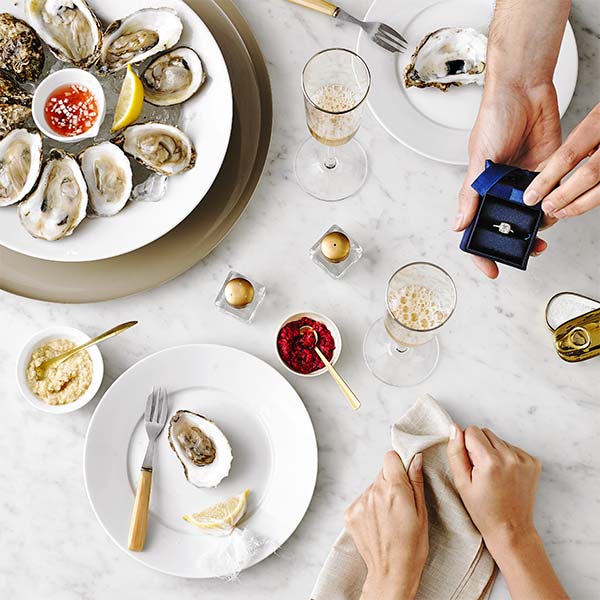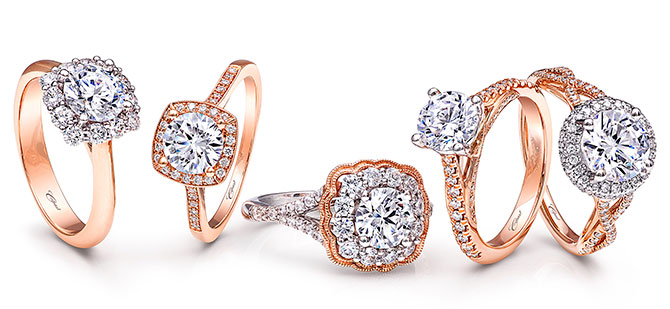
How and why wedding jewelry retailers are creating a social media strategy around their clients’ marriage proposals
It’s no surprise that many of our best-known stories and literary classics—from Sleeping Beauty to Shakespeare—feature a wedding as a central plot point: The celebration of marriage is one of humankind’s most compelling and enduring stories.
Today, savvy jewelers are transforming this timeless appeal by making clients’ wedding stories a key part of their social media marketing, flooding their Instagram feeds with smiling couples and sparkling rings—and as with any good romance, their audience is transfixed.
“For better or worse, we’re in an experience economy,” says Pam Danziger, president of Stevens, Pa.–based Unity Marketing. “You’re not really selling product anymore; you’ve got to be able to deliver on experiences that are meaningful to the customers,” she says, and “story-based retail” can be a key part of that.
 14k rose gold rings with diamonds; $1,000–$4,000 (center stones not included); Coast Diamond; 800-523-5937; coastdiamond.com
14k rose gold rings with diamonds; $1,000–$4,000 (center stones not included); Coast Diamond; 800-523-5937; coastdiamond.com
Wooing Them
“People love a good love story,” says Scott Udell, president of Manhasset, N.Y.–based Two by London, the engagement- and bridal-focused brand from London Jewelers, which has been highlighting customers’ engagement celebrations on its social feeds and website for the past few years. “It’s organically happy stories that people love to read and love to hear more of—it’s like a feel-good moment.”
At Single Stone in Los Angeles, the owners feature client engagement and wedding stories and photos on the store’s social media pages and blog. “We wanted to create more of a personal connection, and what’s better than seeing who the end product ends up going to?” says marketing manager Arielle Madilian.
Beyond connecting with clients, retailers say sharing photos of customers does wonders for clicks. “If I post a picture of a bridal piece in our collection versus a picture of an engagement, the engagement one gets two to three times as many likes,” says John-Frazier Strickland, sales manager at Faith Jewelers in Jacksonville, Fla. His customers have been increasingly receptive to sharing photos and stories about their wedding experiences. “It’s that personal element—people love good news.”
Popping the Question
 Want to feature happy client couples in your marketing? The first step is asking for permission. While this might seem daunting, marketing pros say the proliferation of social platforms, especially visually driven sites such as Instagram and Pinterest, in wedding planning has encouraged many people to be open to sharing their big announcement with the world.
Want to feature happy client couples in your marketing? The first step is asking for permission. While this might seem daunting, marketing pros say the proliferation of social platforms, especially visually driven sites such as Instagram and Pinterest, in wedding planning has encouraged many people to be open to sharing their big announcement with the world.
“When we sell an engagement ring, we ask them from the very beginning if they want to be featured on our social media, on our Facebook page, or on our Instagram feed,” Udell says, adding that about 9 in 10 people are happy to oblige. “They’re reaching back out to tell us how great the proposal was, and we hear the story of how they popped the question, and of course we ask for their handles if they want to be tagged.”
Today’s culture of sharing means the answer, more often than not, is yes.
“Younger customers aren’t as concerned about privacy, and this is a way we can humblebrag for them,” Strickland says. “Everybody wants to show off, but if an individual does a post like we do, that can come off as arrogant. We can basically do that for them.”
Spreading the News
 Most retailers who share client engagement or wedding stories say Instagram is the best tool for this tactic: A mix of tagging the couple, relevant hashtags, and a line or two of glowing congratulations is the “secret sauce.”
Most retailers who share client engagement or wedding stories say Instagram is the best tool for this tactic: A mix of tagging the couple, relevant hashtags, and a line or two of glowing congratulations is the “secret sauce.”
Marketing experts also advise cross-posting across other social channels such as Facebook and Pinterest. Facebook allows for more dialogue, while images can go viral more quickly on Instagram, thanks to users searching for hashtags.
While Instagram is the central platform for this kind of client storytelling, jewelers are spotlighting their bridal clients via other communication methods as well, such as store blogs, websites, or email newsletters featuring happily engaged clients.
Along with a variety of outreach methods, the clients you feature should reflect a similar diversity. Yes, young heterosexual couples might compose the bulk of your wedding business, but jewelers who highlight customer stories say they benefit from featuring a wide swath of demographics, including a variety of ages, races, and orientations.
“If you already have an idea of what you want your wedding to look like, it’s fun to see different types of couples,” Strickland says, adding that Instagram users love proposal imagery that evokes inclusiveness.
To Have and to Hold
 Jewelers say the practice of highlighting clients’ wedding stories pays dividends in recruiting new customers and retaining existing ones.
Jewelers say the practice of highlighting clients’ wedding stories pays dividends in recruiting new customers and retaining existing ones.
“A lot of people come to us because their friends referred them,” Madilian says. “It’s a lot of client-based referrals, both via Instagram or in person.”
Featuring customers’ warm and fuzzy moments will help your business stand out, says Shane O’Neill, vice president at Fruchtman Marketing in Toledo, Ohio. Jewelers report that these posts spark an unprecedented level of engagement, he says: “In terms of real stories, I think that’s part and parcel of retailers trying to give a more personal side to the jewelry business.”
According to O’Neill, “stories and real-life situations have always resonated on social.”
Portraying real people and authentic relationships in your social media marketing will also help you retain existing customers. After all, the young adults who make up the bulk of the engagement and wedding jewelry–buying public are at a life stage where a great experience can make them a customer for the long haul, says Thomai Serdari, a luxury marketing professor at New York University.
As Udell points out, being part of a couple’s wedding, a major milestone, offers jewelers an unparalleled opportunity to forge a lasting relationship. “It’s…a great way for the customer to keep in touch with us after their purchase.”
With smart marketing and creative use of social media, you can continue to provide the experiences these young customers crave. When they feel a personal connection with your business, consumers become lifelong buyers who will look to you for help in celebrating the important occasions in their lives.
“The younger consumer is used to participating in some experiential event that brings them closer,” Serdari says. “Storytelling resonates emotionally with customers because they have the chance to link that experiential factor that’s very appealing—not just to millennials, but everybody.”
(Top image: Jenna Gang/thelicensingproject.com; women: Tom and Steve/Getty; selfie: Tegra Stone Nuess/The Image Bank/Getty; sand: Peter Cade/The Image Bank/Getty)